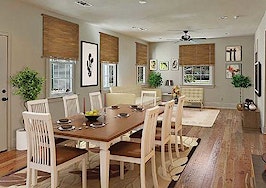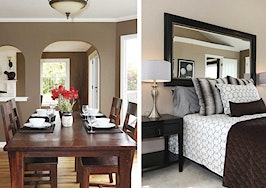Home staging is something that a professional or a do-it-yourself-oriented homeowner can do. There is no question some level of staging must happen on just about every listing — if for no other reason than to stand out next to the competition and sell with fewer days on the market.
As agents, we see prospective sellers every day who love the style or design of their homes. But that doesn’t mean that everyone coming through the door at an open house or property showing will feel the same way. What might appeal to the seller might be a put-off to a prospective buyer.
What are some frequent staging mistakes I see?
Being too personal and rooms with an identity crisis
Home staging is meant to create a neutral canvas that will appeal to the majority of buyers. Staging is all about depersonalizing the space, and creating more of a new- or model-home feel that will appeal to almost everyone.
When preparing to sell a home, help the seller see that this is not a time to show off their personal style, but rather when we can create a look that appeals to more than just the homeowner’s personal tastes.
This idea can extend to the room’s day-to-day use within a home. If a room was intended to be a bedroom but the current use is for kid’s playroom, an office or some other purpose, turn it back into a bedroom.
Be sure homebuyers, who see the property and might not have the vision for what the room could be, don’t get distracted by how the current homeowners are using the room. I walked a new listing the other day where the dining room was wall-to-wall toys — no table and chairs; just toys. I have been there myself as a dad with four kids, yet when selling, my best advice for that mom and dad was to turn the dining room back into a dining room as we market it for sale.
Put away personal treasures
Anything that detracts from the buyer remembering your house needs to be boxed up and removed away. I have walked through homes where my eyes couldn’t help noticing “hundreds” of tiny clocks the seller collected or crawfish magnets that covered every square inch of the refrigerator. Cases of statues and figures that diverted the buyer’s eyes away from focusing on the floor plan and caused them to miss the house during a showing.
Using dark paint colors
When painting, help the homeowner choose a simple, neutral color palette, such as beige tones, gray tones or pale greens. It always amazes me the transformation a few coats of fresh paint will make on a home. Darker colors make a room feel smaller and more closed in — cave-like, if you will.
I had a listing a few years ago where the biggest feedback we kept getting was over a dining room painted a dark blue color. The seller painted it a fresh white, it seemed twice as large, and it sold on the next showing. Also painting inside and out with a new white trim coat will do wonders for making the house pop.
Not taking advantage of natural light
If a room or home feels dark, it will be a significant complaint that appears over and over in showing feedback. People love natural light, so blocking off any light with heavy curtains or furniture can hurt your sale, especially if the home has attractive views.
The other day, I just walked a house with a prospective home seller, where they had a 60-inch TV sitting in front of a double window overlooking the blooming azaleas in the backyard All you could see, however, was a massive box, which completely obfuscated the view of the beautiful flowers.
Also, anything that appears to be dated in a home is a turnoff to a potential buyer. Window treatments can potentially date a home. I had another client who changed “light sucking” dark laminate countertops out of the kitchen for a lighter granite. What a difference in terms of how much brighter the space was in addition to the obvious added benefit of granite in the kitchen.
Thinking more is better
Remove or reduce the amount and size of furniture in the home and particular rooms, as discussed below. Remember that furniture, when selling a home, is to define the purpose of the space. You don’t want a smaller master suite, for example, to have wall-to-wall dressers and a king-sized bed if this emphasizes the smallness of the space. Note high-traffic patterns around the house. If there are furniture pieces in the way or furniture that makes a pathway to a hallway, bedroom, etc., tight, then remove or rearrange to open up the space.
Remember, staging a home means showcasing the property’s highlights and features. Staging to me as an agent also is defined by making sure I communicate to my client the need for handling deferred maintenance items to help a home feel cared for and maintained.
When selling a home, it is not about the owner and their particular design. It is about making sure that design or staged home you are marketing for sale appeals to the broadest group of homebuyers. Make it as neutral a canvas as can be found, and you will get a buyer quicker and for top dollar.
Stay tuned for “Avoid staging mistakes and get that new listing sold: Part 2” next week.
Hank Bailey is an associate broker, Realtor, at Re/Max Legends. You can follow him on Facebook or Twitter.



